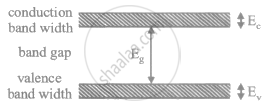Advertisements
Advertisements
प्रश्न
Three photo diodes D1, D2 and D3 are made of semiconductors having band gaps of 2.5 eV, 2 eV and 3 eV, respectively. Which 0 ones will be able to detect light of wavelength 6000 Å?
उत्तर
In Photodiodes, electron and hole pairs are created by the junction photoelectric effect. That is the covalent bonds are broken by the EM radiations absorbed by the electron in the V.B. These are used for detecting light signals.

According to the problem,
The wavelength of light λ = 6000 Å = 6000 × 10-10 m
The energy of the light photon `E = (hc)/λ = (6.6 xx 10^-34 xx 3 xx 10^8)/(6000 xx 10^-10 xx 1.6 xx 10^-19)` eV = 2.06 eV
The incident radiation is detected by the photodiode D2 because the energy of incident radiation is greater than the band gap.
APPEARS IN
संबंधित प्रश्न
Distinguish between a conductor, a semiconductor and an insulator on the basis of energy band diagrams.
In semiconductors, thermal collisions are responsible for taking a valence electron to the conduction band. Why does the number of conduction electrons not go on increasing with time as thermal collisions continuously take place?
We have valence electrons and conduction electrons in a semiconductor. Do we also have 'valence holes' and 'conduction holes'?
Electric conduction in a semiconductor takes place due to
An electric field is applied to a semiconductor. Let the number of charge carries be nand the average drift speed by v. If the temperature is increased,
Let np and ne be the number of holes and conduction electrons in an intrinsic semiconductor.
The impurity atoms with which pure silicon may be doped to make it a p-type semiconductor are those of
(a) phosphorus
(b) boron
(c) antimony
(d) aluminium.
In a pure semiconductor, the number of conduction election 6 × 1019 per cubic metre. How many holes are there in a sample of size 1 cm × 1 mm?
If the lattice constant of this semiconductor is decreased, then which of the following is correct?

For germanium crystal, the forbidden gas energy gap
